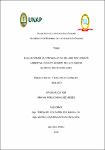Evaluación de la contaminación del aire por hongos ambientales en los museos de la ciudad de Iquitos. Loreto, Perú-2022
Abstract
The city of Iquitos exhibits its history through its museums, where we find paintings, photo frames, wood, statues, handicrafts, which are damaged by fungi and constitute a health risk; Therefore, the present research work was developed between the months of september to december 2021, with the objective of evaluating air pollution by environmental fungi in the museums of the city of Iquitos. The research was descriptive, longitudinal and quantitative. The gravimetric method of plate sedimentation with potato dextrose agar was used, incubating at room temperature for 4 or 5 days. The macroscopic identification was carried out observing the characteristics of the colonies and for the microscopic identification the humid chamber technique was used, taxonomic keys were used. In the present investigation, 519 colonies of environmental fungi were obtained, 180 colonies in the Mi Iquitos Museum and 339 in the Iquitos Amazon Museum; Sterile mycelium was the fungus with the highest relative density (33.91%), followed by Yeast (25.43%), Penicillium sp (12.72%) and with the lowest density were Rhizopus sp, Pestalotia sp and Aspergillus terreus (0.19%). In the scale of contamination degrees, the Iquitos Amazon Museum obtained the category of high contamination with 1117 cfu/m3, while the Mi Iquitos Museum obtained 288 cfu/m3 corresponding to the intermediate category of contamination. Temperatures ranged between 27°C - 29°C and ambient humidity was between 80% and 58%. La ciudad de Iquitos, exhibe su historia a través de sus museos, donde encontramos pinturas, cuadros de fotos, maderas, estatuas, manualidades de artesanía los que son deteriorados por los hongos y constituyen un riesgo para la salud; por lo que el presente trabajo de investigación se desarrolló entre los meses de setiembre a diciembre del 2021, con el objetivo evaluar la contaminación del aire por hongos ambientales en los museos de la ciudad de Iquitos. La investigación fue descriptivo, longitudinal y cuantitativo. Se utilizó el método gravimétrico de sedimentación en placa con Agar papa dextrosa, incubándose a temperatura ambiente por 4 o 5 días. La identificación macroscópica se realizó observando las características de las colonias y para la identificación microscópica se usó la técnica de la cámara húmeda, se usaron claves taxonómicas. En la presente investigación se obtuvieron 519 colonias de hongos ambientales,180 colonias en el Museo Mi Iquitos y 339 en el Museo Amazónico Iquitos; Micelio estéril fue el hongo con más densidad relativa (33.91%), seguido de Levadura (25.43%), Penicillium sp (12.72%) y con menos densidad fueron Rhizopus sp, Pestalotia sp y Aspergillus terreus (0.19%). En la escala de grados de contaminación el Museo Amazónico Iquitos obtuvo la categoría de alta en contaminación con 1117 ufc/m3, mientras el Museo Mi Iquitos obtuvo 288 ufc/m3 correspondiendo a la categoría intermedia de contaminación. Las temperaturas oscilaron entre 27°C - 29°C y la humedad ambiental estuvo entre el 80% y 58%.
Collections
- Tesis [417]


